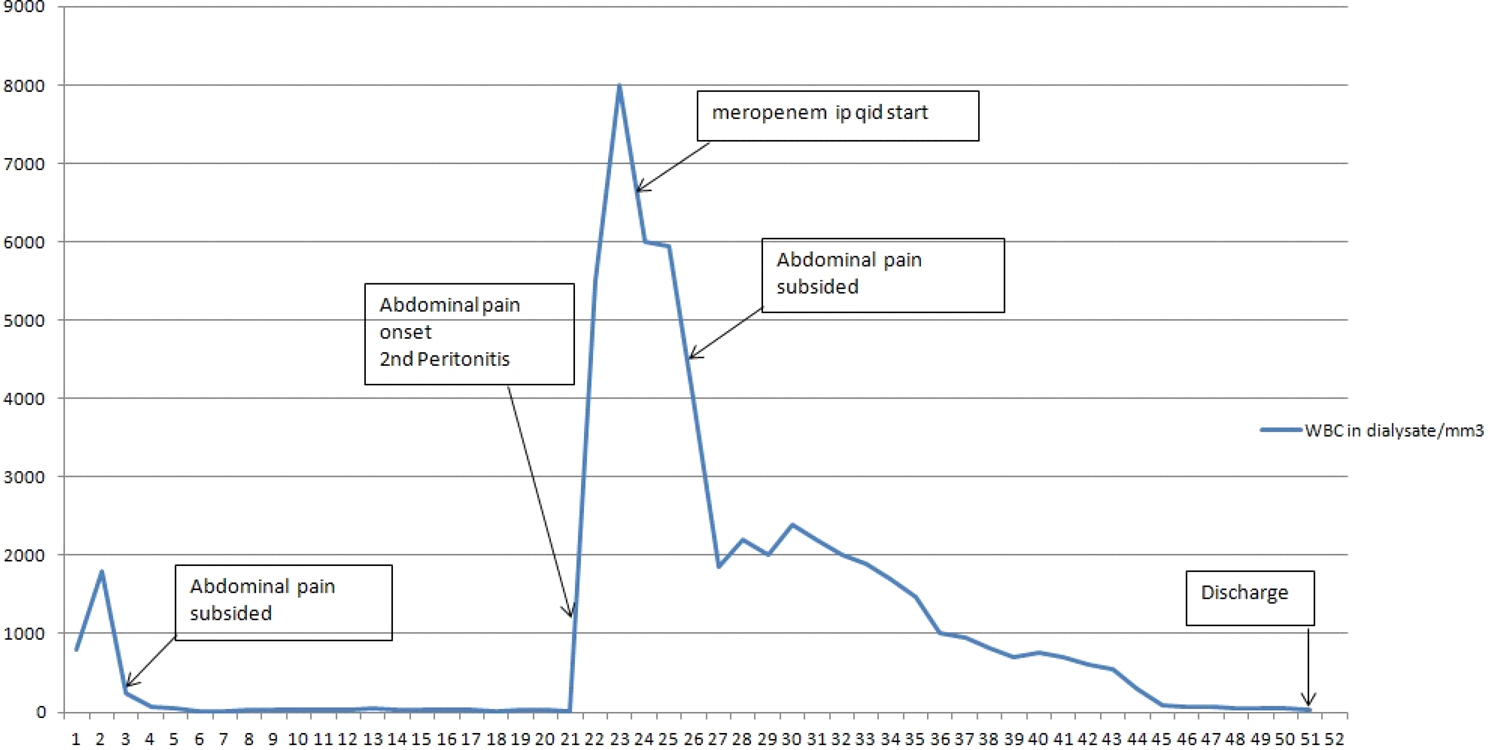Articles
- Page Path
- HOME > Kosin Med J > Volume 28(1); 2013 > Article
-
Case Report
Extended Spectrum β-lactamase–producingE. coli -related Nosocomial Peritonitis Treated Successfully with Meropenem in a Patient on Peritoneal Dialysis - Seong Kyu Jeong1, Yeong Hee Ham1, Jin Hyuk Jo1, Yeong Sin Sin1, Dong Heo1, Hark Rim2
-
Kosin Medical Journal 2013;28(1):43-47.
DOI: https://doi.org/10.7180/kmj.2013.28.1.43
Published online: January 19, 2013
1Department of internal medicine, Daedong Hospital, Busan, Korea
2Department of nephrology medicine, Kosin University Gospel Hospital, Busan, Korea
- Corresponding author: Seong Kyu Jeong, Department of internal medicine, Daedong Hospital, 187, Chungnyeol-daero, Dongnae-gu, Busan, Korea TEL: +82-10-9650-2666 FAX: +82-51-553-7575 E-mail: sk-jeong82@hanmail.net
• Received: March 14, 2012 • Accepted: April 2, 2012
Copyright © 2013 Kosin University School of Medicine Proceedings
This is an Open Access article distributed under the terms of the Creative Commons Attribution Non-Commercial License (http://creativecommons.org/licenses/by-nc/3.0/) which permits unrestricted non-commercial use, distribution, and reproduction in any medium, provided the original work is properly cited.
- 1,006 Views
- 4 Download
Abstract
- Peritonitis is a common and potentially serious infection in patients undergoing continuous ambulatory peritoneal dialysis (CAPD). The most common organisms usually associated with CAPD peritonitis are Staphylococcus aureus and Staphylococcus epidermidis. Rarely, aerobic gram negative bacilli have been the causative agents of CAPD peritonitis. The treatment of CAPD peritonitis requires removal of the peritoneal catheter and treatment with parenteral antibiotics active against the causative pathogen. While hospitalized for CAPD peritonitis, a 55-year-old man on CAPD had nosocomial peritonitis secondary to infection by ESBL–producing E. coli, that was sensitive to imipenem and meropenem. He was treated successfully with a 4-week course of intraperitoneal meropenem therapy without subsequent relapse, loss of peritoneal catheter, ultrafiltration failure, or dialysis inadequacy.
Fig. 1.The clinical evolution of hospital course (x axis is admission date. y axis is dialysate WBC count).


Table 1.Sensitivity pattern for extended spectrum β-lactamase Escherichia coli strain
- 1.Li PK, Szeto CC, Piraino B, Bernardini J, Figueiredo AE, Gupta A, et al. Peritoneal dialysis related infections recommendations: 2010 update. Perit dial int 2010;30:393–423.ArticlePubMed
- 2.Kim DK, Yoo TH, Ryu DR, Xu ZG, Kim HJ, Choi KH, et al. Changes in causative organisms and their antimicrobial susceptibilities in CAPD peritonitis: a single center's experience over one decade. Perit dial int 2004;24:424–32.ArticlePubMed
- 3.Nathisuwan S, Burgess DS, Lewis JS 2nd. Extended-spectrum beta-lactamases: epidemiology, detection, and treatment. Pharmacotherapy 2001;21:920–8.ArticlePubMed
- 4.Palucha A, Mikiewicz B, Gniadkowski M. Diversification of escherichia coli expressing an SHV-type extended-spectrum beta-lactamase (ESBL) during a hospital outbreak: Emergence of an ESBL-hyperproducing strain resistant to expanded-spectrum cephalosporins. Antimicrob Agents Chemother 1999;43:393–6.ArticlePubMedPMCPDF
- 5.Yip T, Tse KC, Lam MF, Tang S, Li FK, Choy BY, et al. Risk factors and outcomes of extended-spectrum beta-lactamase-producing E. coli peritonitis in CAPD patients. Perit dial int 2006;26:191–7.ArticlePubMed
- 6.Tedla FM, Salifu M, Friedman EA. Successful treatment of vancomycin-resistant enterococcal peritonitis with linezolid in a kidney transplant patient: a case report and review of the literature. Perit Dial Int 2004;24:70–2.ArticlePubMed
- 7.Valdes-Sotomayor J, Cirugeda A, Bajo MA, del Peso G, Escudero E, Sanchez-Tomero JA, et al. Increased severity of escherichia coli peritonitis in peritoneal dialysis patients independent of changes in in vitro antimicrobial susceptibility testing. Perit Dial Int 2003;23:450–5.ArticlePubMed
- 8.Troidle L, Gorban-Brennan N, Kliger A, Finkelstein F. Differing outcomes of gram-positive and gram-negative peritonitis. Am J Kidney Dis 1998;32:623–8.ArticlePubMed
- 9.Saklayen MG. CAPD peritonitis. Incidence, pathogeng, diagnosis, and management. Med Clin North Am 1990;74:997–1010.PubMed
- 10.Park SH, Lee DH, Cho YJ, Cho DK, Shin SK, Kim DJ, et al. Causative organisms and patterns of antibiotics sensitivity of capd peritonitis in different dialysis centers.Korean J Med 2003;64:682–9.
- 11.Colodner R, Rock W, Chazan B, Keller N, Guy N, Sakran W, et al. Risk factors for the development of extended-spectrum beta-lactamase-producing bacteria in nonhospitalized patients. Eur J Clin Microbiol Infect Dis 2004;23:163–7.ArticlePubMed
- 12.Khurana S, Taneja N, Sharma M. Extended spectrum beta-lactamase mediated resistance in urinary tract isolates of family enterobacteriaceae. Indian J Med Res 2002;116:145–9.PubMed
References
Figure & Data
References
Citations
Citations to this article as recorded by 


 KOSIN UNIVERSITY COLLEGE OF MEDICINE
KOSIN UNIVERSITY COLLEGE OF MEDICINE
 PubReader
PubReader ePub Link
ePub Link Cite
Cite

